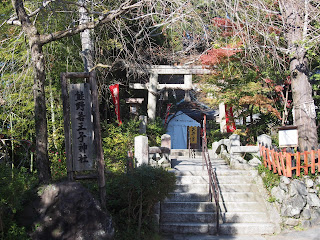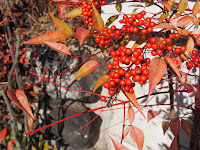#3 Takenobu Inari Shrine (武信稲荷神社)
This shrine is well known for giving a victory and assisting expecting couples with naming their baby.
There are couples of tori at Takenobu Inari Shrine.
Takenobu Inari Shrine is the setting of the tale of old Japan: Issun-boshi (一寸法師), Japanese Tom Thumb. Issun-boshhi is familiar to Japanese children as well as Momo-taro (桃太郎) or Urashima-taro (浦島太郎).
Isshun-boshi
A summary of Issun-boshi
Long, long ago, there was a man who is only a sun tall. He had never grown taller any more so was named Issun-boshi. (Issun means a sun.) One day he made his mind to be a samurai, so he likened a needle to a sword and went down a river onto a bowl boat paddling by a chopstick head for Kyoto.
After coming to his destination safely, Issun-boshi lived and worked at the most biggest premises in Kyoto. He went along with the princess when she visited the Kiyomizu-dera because he pleased his lord, Sanjo-daijin Dono. However, they were attacked by a ogre while on a journey, and Issun-boshi was swallowed. Just then, Issun-boshi brandished his needle in the ogre's stomach. It couldn't stand the pain, and it ran for its life after spat out him.
The ogre dropped the Uchideno-kozuchi, a mallet of good luck. It is believed that dreams come true when you shake it. As Issun-boshi shook the Uchideno-kozuchi, he was grown rapidly up to be a man. He married the princess and they lived well ever after with bringing out worldly possessions.
the Japanese hackberry
Takenobu Inari Shrine is also famous for the power of matchmaking. Japanese hackberry is called Enoki (榎) in Japanese, but it is also called En-no-ki(えんの木). The meaning of En is a turn of fate or destiny.
Here is the story that strengthen the power of matchmaking. When Ryoma SAKAMOTO, 坂本龍馬, who was a patriot during Bakumatsu period in Japan, was in hiding in Kyoto from enemies, he went to Takenobu Inari Shrine because this is their memorable place they often visited, and engraved his name on the body of the tree in order to let his wife, Oryo, know he was alive. After that they could meet again.
Ema(絵馬) which has pictures of Ryoma and Oryo drawn on it
A chainsaw art dragon made of a branch fallen down from the tree.
----------------------------------------------------------------------------------------------------------------
Adress: 38, Imashinzaike Nishi-cho, Nakagyo-ku, Kyoto-shi, Kyoto, 604-8801
Access: It is about 10 minutes walk from Omiya Station (大宮駅) on the Kyoto line of Hankyu Railway(阪急電鉄京都線) / Shijo-Omiya Station (四条大宮駅) on the Arashiyama main line of Keihuku Railway(京福電鉄 嵐山本線) / Nijo-jyou Mae Station (二条城前駅) on the Tozai line of Kyoto City Subway (京都市営地下鉄東西線) / Nijo Station (二条駅) of JR.
----------------------------------------------------------------------------------------------------------------
If you are interested in Japanese-style vow renewal at this shrine, visit our website and submit the application form. →http://wrappedinjapan.jp
See ya!




















































